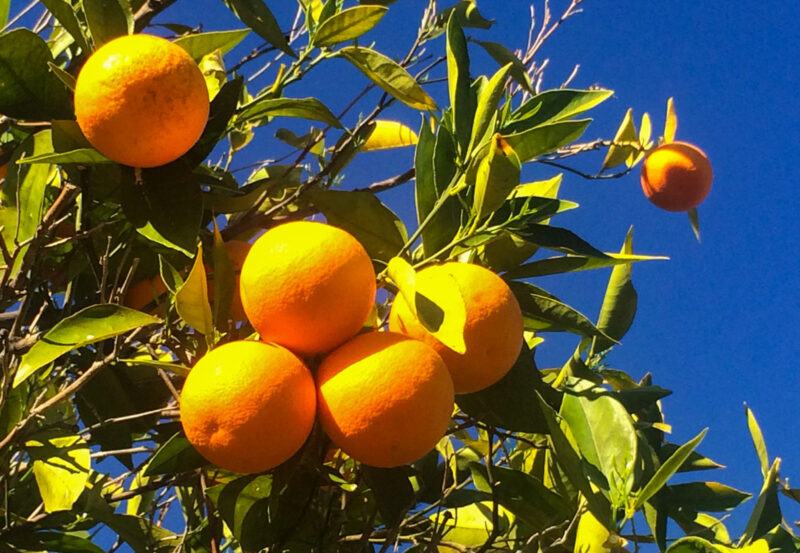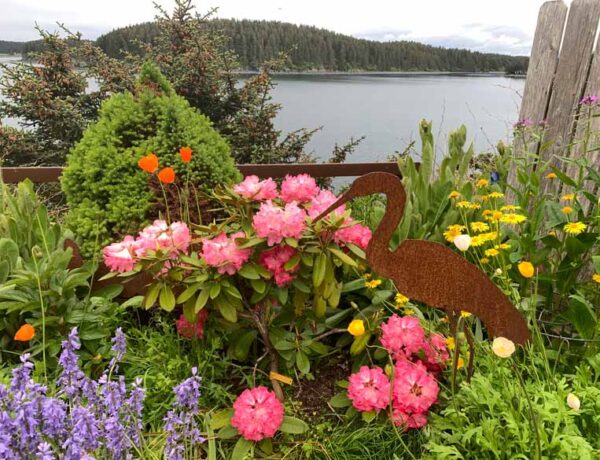If you’ve been toying with the idea of growing some of your own food, it’s time to get serious about it. Thanks to California’s current drought–reported to be the worst in 100 years–food prices are on the rise…

Our raised beds are thawed out, so I took a break from making bread (note the apron) to turn the soil.
California, which has the nation’s largest farm economy (more than 90 percent of the U.S. production of broccoli, celery, almonds, grapes, walnuts and other crops), seems to be in a perennial drought. While 2013 may have set a new standard as the driest year on record, going back 160 years, this year is not looking good. So far in 2014, geologists say the Sierra snowpack—a crucial source for state water—is only 20 percent of normal.
Why is California so dry? Meteorologists say there’s a huge, stubborn high pressure system (also called the Ridiculously Resilient Ridge) off the West Coast nearly 4 miles high and 2,000 miles long. It isn’t budging.

Can you pick out Alaska and the West Coast? This snapshot gives you an idea of the jet stream “wrinkle” that is causing havoc.
“About 65 percent of our cropland [about one million acres] is irrigated,” says Karen Ross, California Secretary of Food and Agriculture, “So it is very serious.
“It is not just isolated to one part of the state. We have a number of our counties that are under extreme drought conditions. We are already seeing farmers choose to fallow land that normally this time of the year they would be preparing for a springtime crop or a summer crop.”
Which means nut trees will have more priority than seasonal crops like lettuce and tomatoes. And since most of the nation’s salad bar is grown in California’s San Joaquin Valley, produce prices could rise.

Mixed salad greens are the easiest, fastest, and most economical crops to grow in the home garden. (Marion Owen photo)
What does that mean for you and me?
In the U.S., fruits and vegetables account for about 1.2 percent of a typical household’s spending, according to the Bureau of Labor Statistics. California’s drought could also impact the prices of dairy products and meat. A 10 percent increase in food costs could add 0.4 percent to the annual rate of inflation.
Uhhh, 0.4 percent? It might not seem like much, 0.4 percent, but to an economist, that’s huge.
Meanwhile, a recession seems to be increasingly likely this year. Oops, really?
Here’s a little history lesson: According to the National Bureau of Economic Research, data shows that the average economic expansion since World War II has lasted 58 months. The current expansion that we’re experiencing now began 55 months ago in June 2009 and could end this year as consumer spending slows.
Moving away from speculation, while California is unusually dry and hot for this time of year, why then, is Alaska so wet and warm? The Associated Press gave us a clue recently: The jet stream–the river of air that dictates much of America’s weather–is meandering again. Which means warm air is flowing from near Hawaii north to Alaska and from Canada south to the Lower 48.
“It’s like a fire hose is turned on Alaska at full blast,” said a National Weather Service meteorologist in a recent broadcast.

Carrots are so versatile (pickles, savory, sweet, fresh, steamed, roasted) they should be grown in every garden.
So let’s turn a fire hose on rising food prices by growing more local food. If you’re new to gardening, you might be wondering, where to start?First, build a raised bed. Use whatever materials work best: Stones, cement blocks, rough-cut lumber from the sawmill, 4×6’s from your local hardware store, driftwood, re-conditioned pallets. The length is not so important as the width. Make your raised beds 4 to 6 feet wide, narrow enough so you can reach in from both sides.
Fill it with local soil, and local materials such as leaves, kelp, sand, fish meal, compost and aged manure — goat, chicken, horse, cow, buffalo. [You can see that Kodiak Island is blessed with a treasure-trove of garden goodies] Yes, it will seem too lumpy but don’t worry. In a few months, it will have broken down and settled a bit. Come planting time, top it off with a couple inches of sifted soil or compost.
If building a raised bed means reducing the size of your lawn, have at it. A sprawling expanse of green is overrated in this country. Besides, you can’t eat a lawn so you might put you yard to work by growing edible, as well as beautiful food. With the rising cost of food and concern about food safety, you can’t go wrong by growing a few heads of lettuce or broccoli.
No room for raised beds? Half-barrels, halibut tubs, totes, window boxes, narrow raised beds, and hanging baskets, all make excellent containers. A community garden or a shared garden with your neighbor might be the answer, too.
Finally, what to grow? Here’s a list of easy-to-grow, veggies that love coastal Alaska growing conditions:
Kale, broccoli, mustard greens, lettuce, carrots, potatoes, cress, Swiss chard, spinach, radishes, peas, fava beans, beets, cabbage, and Chinese cabbage.
You may have noticed that tomatoes and cucumbers are not listed above. If you’re a hoop or greenhouse grower though, they’re do-able. Allan Thielen, Kodiak’s cucumber king, swears by Jade cucumbers from Johnny’s Selected Seeds. As for tomatoes, many early and cherry varieties do well in protected conditions. One to try this year: Gregori’s Altai Tomato from Tomato Growers, which originates near the Chinese border with Siberia and produces slightly flattened beefsteak tomatoes in 65 days.
Speaking of Siberia, as I write this, the temperature has tanked at -63 degrees F.
 NOTE: This article was originally published in the Kodiak Daily Mirror as one of my weekly garden columns. I edited it for this blog posting to make it more relevant for readers who don’t live in Alaska.
NOTE: This article was originally published in the Kodiak Daily Mirror as one of my weekly garden columns. I edited it for this blog posting to make it more relevant for readers who don’t live in Alaska.






3 Comments
marionowen
November 14, 2014 at 10:48 AMWow Daryle, you’ve got serious bragging rights here. Good for you. I’ll be trying biochar this year; hopefully it’ll work just fine in Kodiak, Alaska. Thanks for your comment. Cheers!
Daryle Thomas
November 14, 2014 at 9:59 AM2014 marks the second year in a row that I grew more than 40 full-sized cucumbers in a planter that measures 22 1/2″ by 22 1/2″ by 9″ deep.Last year’s Socrates F1 tasted better than this year’s Picolino F1. The raised bed is on wheels and occupies a section of a parking lot. The soil, treated with lactic acid bacteria and biochar, produced leaves measuring 10″ across. Stopped traffic!